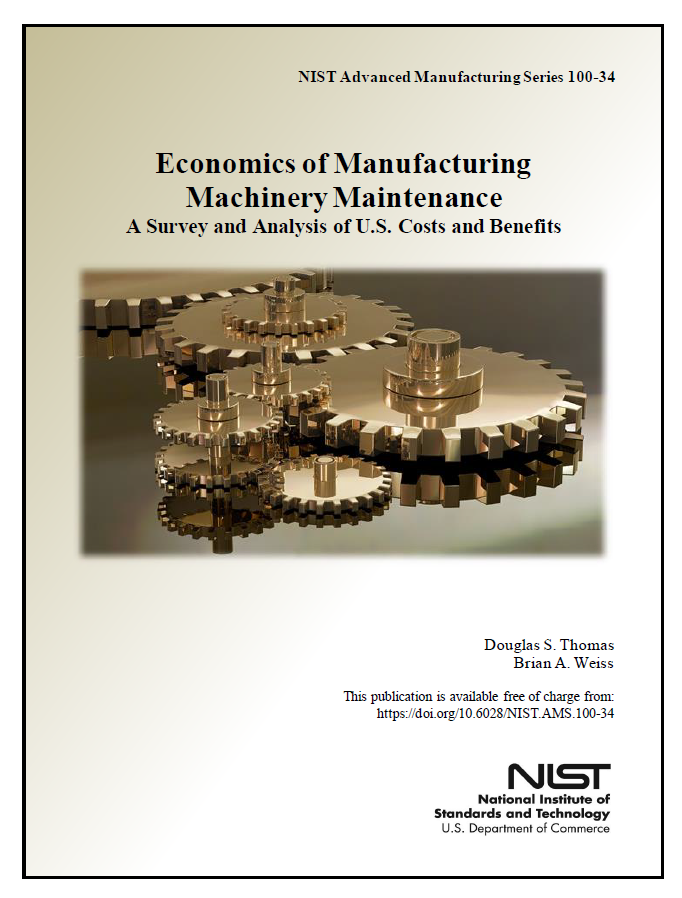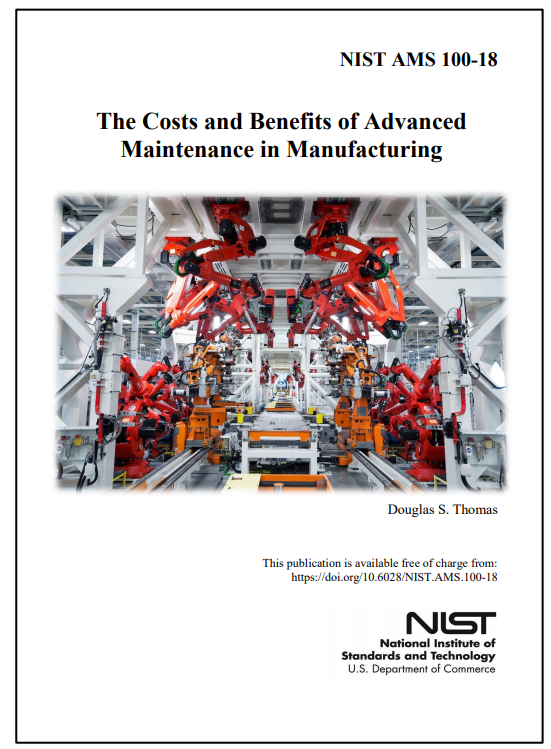Manufacturing Machinery Maintenance
Applied Economics in US Manufacturing

A number of terms have been used to discuss the use of digital technologies in manufacturing, including smart manufacturing, digital manufacturing, cloud manufacturing, cyber-physical systems, the industrial internet-of-things, and Industry 4.0. One of the applications of digital technologies is in the area of machinery maintenance. Two projects at NIST aim to improve maintenance methods and standards: Prognostics and Health Management for Reliable Operations in Smart Manufacturing and Knowledge Extraction and Application for Manufacturing Operations. There are three maintenance types that are, generally, referenced in this work:
- Predictive maintenance, which is analogous to condition-based maintenance, is initiated based on predictions of failure made using observed data such as temperature, noise, and vibration.
- Preventive maintenance, which is related to scheduled maintenance and planned maintenance, is scheduled, timed, or based on a cycle
- Reactive maintenance, which is related to run-to-failure, corrective maintenance, failure-based maintenance, and breakdown maintenance, is maintenance done, typically, after equipment has failed or stopped.
There are a wide range of estimates for the costs of machinery maintenance in manufacturing. Some estimates put it between 15 % and 70 % of the cost of goods produced. In terms of impacts of implementing advanced maintenance techniques, there are wide ranging estimates using a number of metrics (see the table below). To better understand costs of maintenance and potential benefits of advanced maintenance, the National Institute of Standards and Technology (NIST) collected data from manufacturers. The results were published in NIST AMS 100-34 (see below), which examined the costs of machinery maintenance along with losses due to inadequate maintenance strategies in discrete manufacturing (NAICS 321-339, excluding NAICS 324 and 325). It further examined the perceived and observed benefits of investing in and advancing maintenance strategies.
Maintenance Costs: 2016 Machinery maintenance expenditures for NAICS 321-339 (excluding 324 and 325) were estimated to be $57.3 billion. Additional expenditures due to faults and failures were estimated at $16.3 billion and costs for inventory to buffer against maintenance issues costed $0.9 billion. In total, these maintenance activities costed $74.5 billion.
Preventable Losses: The 2016 losses due to preventable maintenance issues amounted to $119.1 billion: $18.1 billion due to downtime, $0.8 billion due to defects, and $100.2 billion due to lost sales from delays and defects. Additionally, an estimated 16.03 injuries and 0.05 deaths per million employees were associated with these maintenance issues.
Benefits of Advanced Maintenance Strategies: The estimated 2016 perceived benefit of adopting some additional amount of predictive maintenance was $6.5 billion from downtime reduction and $67.3 billion in increased sales ($73.8 billion in total). Other perceived benefits such as reduced defects are also likely to occur but were not monetized.
The top 25 % of those establishments relying on reactive maintenance was associated with 3.3 times more downtime than those in the bottom 25 %. They were also associated with 16.0 times more defects, 2.8 more lost sales due to defects from maintenance, 2.4 times more lost sales due to delays from maintenance, and 4.9 times more inventory increases due to maintenance issues. On average, 45.7 % of machinery maintenance was reactive maintenance. Those who relied less on reactive maintenance, and more on preventive and/or predictive maintenance, were more likely to use a pull (i.e., make to order) stock strategy and tend to be differentiators as opposed to being a cost competitor. That is, they rely more on their reputation and produce products on demand. The implication being that reactive maintenance reduces quality and increases uncertainty in production time.
Among those establishments that primarily rely on preventive and predictive maintenance (i.e., less than 50 % reactive maintenance), the top 50 % in predictive maintenance was associated with 15 % less downtime, an 87 % lower defect rate, and 66 % less inventory increases due to unplanned maintenance. Those establishments that relied more on predictive maintenance than preventive were more likely to have a pull (i.e., make to order) stock strategy and more likely to be a differentiator as opposed to being a cost competitor. Moreover, predictive maintenance is associated with higher quality products and shorter production times through reduced downtime. For those establishments that invested more heavily into preventive or predictive.

Economics of Manufacturing Machinery Maintenance: A survey and Analysis of U.S. Costs and Benefits:
This report examines costs of machinery maintenance along with losses due to inadequate maintenance strategies in discrete manufacturing (NAICS 321-339, excluding NAICS 324 and 325) using data collected from U.S. manufacturers. The report further examined the perceived and observed benefits of investing in and advancing maintenance strategies. Estimates for costs and losses are annual values for 2016. Machinery maintenance expenditures for NAICS 321-339 (excluding 324 and 325) were estimated to be $57.3 billion for 2016. Losses due to preventable maintenance issues amounted to $119.1 billion. The top 25 % of those establishments relying on reactive maintenance was associated with 3.3 times more downtime than those in the bottom 25 %. They were also associated with 16.0 times more defects, 2.8 more lost sales due to defects from maintenance, 2.4 times more lost sales due to delays from maintenance, and 4.9 times more inventory increases due to maintenance issues.

Maintenance Costs and Advanced Maintenance Techniques
Survey and Analysis: The costs/benefits associated with investing in advanced maintenance techniques is not well understood. This paper uses the results from a survey of manufacturers to estimate the national losses due to inadequate maintenance and make comparisons between those that rely on reactive maintenance, preventive maintenance, and predictive maintenance.

Risk-Based, Investment Analysis for Condition Monitoring Systems in Manufacturing: A Procedural Guide
The procedure in this paper estimates the suitability of a CMS for a system in relatable terms of risk and investment analysis. The procedure incorporates information from sources such as expert opinions, maintenance logs, failure mode documentation, simulations, and ‘best / worst case’ scenario heuristics. While the procedure focuses primarily on evaluating the impact of the CMS software, the procedure could easily extend to include technical and management support necessary to make any software project a success. Fictional case studies are presented in this paper to illustrate the procedure and demonstrate its usefulness and validity.

The Costs and Benefits of Advanced Maintenance in Manufacturing
The manufacturing atmosphere is continually changing with new technologies and standards being swiftly developed. Firms create competitive advantages using their knowledge, skills, supply chains, and processes to create superior products at lower prices. In such a competitive environment, efficient machinery maintenance methods can mean the difference between a thriving profitable firm and one that loses money and sales. Currently, at the national level there is limited understanding of the costs and losses associated with machinery maintenance or the different machinery maintenance techniques. This report examines the literature and data available for estimating the costs and losses relevant to different manufacturing maintenance techniques. It extends further to identify the data needed for making such estimates and the feasibility of collecting the relevant data. This report focuses on, but is not limited to, four categories of manufacturing: machinery, computer and electronic products, electrical equipment, and transportation equipment manufacturers.

Advanced Maintenance in Manufacturing: Costs and Benefits
The costs of maintenance and the potential effect on maintenance costs from adopting predictive maintenance techniques is not well documented at the national level. A number of data items need to be collected to estimate the costs and losses associated with maintenance. This paper examines the current literature on maintenance costs as it relates to advanced maintenance techniques and discusses the feasibility of collecting data to measure the relevant costs and losses. Discussions with manufacturing maintenance personnel suggests that manufacturers are willing and able to provide estimates or approximations of the data needed for estimating the manufacturing costs/losses relevant to advanced maintenance techniques. However, some discussants expressed uncertainty about the willingness to provide some of the data. Some items were not tracked; however, most believed that an approximation could be provided in these cases. In order to estimate maintenance cost for the manufacturing industry as a whole , a sufficient sample size is needed. Depending on the standard deviation, confidence interval, and accepted margin of error, a needed sample size of 77 is estimated, but could reasonably be as low as 14.
Contacts
-
(301) 975-4918

